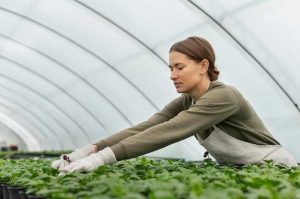

As cities continue to expand and the global population steadily rises, the demand for sustainable and efficient food production methods has become increasingly urgent. In response to this pressing need, a groundbreaking approach has emerged, challenging traditional agricultural practices and offering a promising solution: vertical farming.
This innovative technique, also known as sky farming or multilevel farming, involves the cultivation of crops in vertically stacked layers, utilizing advanced technologies to optimize space, resources, and productivity. By harnessing the power of controlled environments, hydroponics, and aeroponics, vertical farming aims to revolutionize urban agriculture, ensuring a reliable and sustainable food supply for the ever-growing urban population.
One of the key advantages of vertical farming lies in its ability to overcome the limitations of traditional farming methods. By eliminating the need for vast expanses of land, vertical farming opens up a world of possibilities for urban areas, where space is often scarce and valuable. With the ability to grow crops indoors, in high-rise buildings, or even underground, vertical farming offers a transformative solution for cities, allowing them to become self-sufficient in food production and reduce their dependence on external sources.
Moreover, vertical farming presents a host of environmental benefits. By utilizing advanced technologies such as LED lighting, climate control systems, and efficient water management, this innovative approach significantly reduces the need for pesticides, herbicides, and excessive water usage. With the ability to control every aspect of the growing process, from temperature and humidity to nutrient levels, vertical farming minimizes the risk of crop diseases and pests, resulting in higher yields and healthier produce.
With its potential to revolutionize urban agriculture, vertical farming holds the promise of transforming the way we feed our cities. By combining cutting-edge technologies, sustainable practices, and a commitment to food security, this innovative approach has the power to create a greener, more resilient, and self-sufficient future for urban communities around the world.
The Rise of Vertical Farming: A Solution to Urban Food Security
As cities continue to grow and urban populations increase, ensuring food security becomes a pressing concern. Traditional agricultural practices may struggle to meet the demands of urban areas, leading to potential food shortages and increased reliance on external sources. However, the emergence of vertical farming presents a revolutionary solution to this problem.
Vertical farming, also known as urban agriculture, offers a unique approach to cultivating crops in a vertical, stacked manner, utilizing innovative techniques and technologies. By utilizing limited space efficiently, vertical farming maximizes crop production, reducing the need for expansive land areas typically associated with traditional farming methods.
One of the key advantages of vertical farming is its ability to bring food production closer to urban centers, reducing the distance between farms and consumers. This proximity not only reduces transportation costs but also ensures fresher produce, as crops can be harvested and delivered to consumers within a short period. Additionally, vertical farming minimizes the environmental impact associated with long-distance transportation and the use of pesticides and fertilizers.
Furthermore, vertical farming allows for year-round crop production, independent of seasonal changes and weather conditions. By creating controlled environments within vertical farms, factors such as temperature, humidity, and lighting can be optimized to provide ideal growing conditions for various crops. This level of control also enables the cultivation of a wide range of plant species, including those that are not traditionally grown in certain regions.
Another significant benefit of vertical farming is its potential to reduce water usage. Through the implementation of advanced irrigation systems and water recycling techniques, vertical farms can significantly decrease water consumption compared to conventional farming methods. This conservation of water resources is crucial in urban areas where water scarcity is a growing concern.
| Advantages of Vertical Farming: |
|---|
| Maximizes crop production in limited space |
| Brings food production closer to urban centers |
| Enables year-round crop production |
| Reduces water usage |
In conclusion, vertical farming presents a promising solution to address the challenges of urban food security. Its innovative techniques and technologies offer the potential to maximize crop production, reduce environmental impact, and ensure a sustainable and reliable food supply for growing urban populations.
Maximizing Space Efficiency: How Vertical Farms Utilize Every Inch
In the realm of urban agriculture, space is a precious commodity. Vertical farms, employing innovative and resourceful techniques, have emerged as a solution to the limited availability of land in urban areas. These farms utilize every inch of space to maximize efficiency and productivity, revolutionizing the way we grow crops.
One of the key strategies employed by vertical farms is the use of vertical space. Instead of relying solely on traditional horizontal farming methods, these farms take advantage of the vertical dimension by stacking multiple layers of crops. This vertical arrangement allows for a significantly higher crop yield per square foot of land, making the most of the limited space available in urban environments.
Another technique utilized by vertical farms is the integration of hydroponics. By growing plants in nutrient-rich water solutions instead of soil, these farms eliminate the need for large amounts of land. Hydroponics systems can be designed to fit into compact spaces, such as vertical towers or shelves, further maximizing the use of available area. This method also allows for precise control over the growing conditions, resulting in faster growth and higher crop quality.
In addition to vertical stacking and hydroponics, vertical farms also employ advanced lighting systems. By utilizing artificial lighting, such as LED grow lights, these farms can provide the necessary light spectrum for optimal plant growth. This eliminates the reliance on natural sunlight and allows for year-round cultivation, regardless of the external weather conditions. The controlled lighting also enables vertical farms to stack crops more closely together, further increasing space efficiency.
Furthermore, vertical farms make use of advanced automation and robotics. By automating tasks such as planting, watering, and harvesting, these farms reduce the need for human labor and maximize efficiency. Robotic systems can navigate the vertical structures and perform tasks with precision, ensuring that every inch of space is utilized effectively.
Overall, vertical farms are revolutionizing urban agriculture by maximizing space efficiency through the use of vertical stacking, hydroponics, advanced lighting systems, and automation. These innovative techniques allow for higher crop yields, reduced land requirements, and year-round cultivation. As urban populations continue to grow, vertical farming offers a sustainable solution to feed the cities of the future.
Sustainable Agriculture: Reducing Water and Energy Consumption in Vertical Farms
In this section, we will explore the importance of sustainable practices in vertical farming and how they contribute to the reduction of water and energy consumption. By implementing innovative techniques and utilizing alternative resources, vertical farms can minimize their environmental impact while maximizing crop yields.
One key aspect of sustainable agriculture in vertical farms is the efficient use of water. Traditional farming methods often require large amounts of water for irrigation, leading to excessive water consumption and potential water scarcity. However, vertical farms employ advanced irrigation systems that optimize water usage by delivering precise amounts of water directly to the plants’ roots. This targeted approach minimizes water waste and ensures that every drop is utilized effectively.
Furthermore, vertical farms can also reduce water consumption by implementing water recycling and reclamation systems. These systems collect and treat wastewater, allowing it to be reused for irrigation purposes. By recycling water, vertical farms can significantly decrease their reliance on freshwater sources, conserving this valuable resource for other essential needs.
In addition to water conservation, sustainable agriculture in vertical farms also focuses on reducing energy consumption. Traditional farming methods often rely on fossil fuels for machinery operation and transportation, contributing to greenhouse gas emissions and climate change. However, vertical farms utilize renewable energy sources such as solar panels and wind turbines to power their operations. By harnessing clean energy, vertical farms can minimize their carbon footprint and contribute to a more sustainable future.
Moreover, vertical farms employ energy-efficient technologies such as LED lighting systems. These lighting systems provide the necessary light spectrum for plant growth while consuming significantly less energy compared to traditional lighting methods. By utilizing LED lights, vertical farms can reduce their energy consumption and lower their overall operational costs.
In conclusion, sustainable agriculture plays a crucial role in vertical farming by reducing water and energy consumption. Through the implementation of efficient irrigation systems, water recycling, renewable energy sources, and energy-efficient technologies, vertical farms can minimize their environmental impact and contribute to a more sustainable and resilient food production system.
Year-Round Crop Production: Overcoming Seasonal Limitations with Vertical Farming
Ensuring a consistent supply of fresh and nutritious crops throughout the year has always been a challenge for traditional agriculture. However, with the innovative approach of vertical farming, the limitations imposed by seasonal changes can be overcome. By utilizing advanced techniques and technologies, vertical farming offers a sustainable solution to year-round crop production.
Overcoming the constraints of changing seasons
Traditional farming methods heavily rely on favorable weather conditions and specific seasons for optimal crop growth. This dependence on nature’s cycles often leads to limited harvests and a scarcity of certain crops during off-seasons. Vertical farming, on the other hand, eliminates these limitations by creating a controlled environment that can be tailored to meet the needs of various crops.
Creating an ideal growing environment
Vertical farming utilizes indoor facilities equipped with artificial lighting, climate control systems, and hydroponic or aeroponic cultivation methods. These technologies allow farmers to regulate temperature, humidity, light intensity, and nutrient levels, providing crops with an ideal environment for growth. By mimicking the optimal conditions for each crop, vertical farming ensures consistent and high-quality yields regardless of the external climate.
Extending the growing season
One of the key advantages of vertical farming is its ability to extend the growing season beyond traditional limitations. By providing a controlled environment, crops can be cultivated year-round, regardless of the external weather conditions. This not only ensures a continuous supply of fresh produce but also reduces the need for long-distance transportation and storage, resulting in reduced carbon emissions and improved food security.
Enhancing crop diversity and availability
Vertical farming enables the cultivation of a wide range of crops that might not be suitable for traditional farming due to specific climate requirements. By eliminating the constraints imposed by geographical location and seasonal changes, vertical farms can grow a diverse selection of fruits, vegetables, and herbs. This enhances the availability of nutritious and locally grown produce, offering consumers a wider choice and promoting a healthier and more sustainable diet.
Conclusion
Vertical farming revolutionizes crop production by overcoming the limitations imposed by changing seasons. By creating a controlled environment and utilizing advanced technologies, vertical farms ensure year-round cultivation, consistent yields, and enhanced crop diversity. This innovative approach to agriculture has the potential to transform urban food systems, promoting sustainability, and improving food security in an ever-changing world.
Enhancing Crop Quality: The Benefits of Controlled Environments in Vertical Farms
In this section, we will explore the advantages of implementing controlled environments in vertical farms and how they contribute to enhancing the quality of crops. By creating optimal conditions for growth, vertical farms can revolutionize the way we produce food in urban areas.
Optimal Growth Conditions
One of the key benefits of controlled environments in vertical farms is the ability to provide crops with optimal growth conditions. By carefully regulating factors such as temperature, humidity, and lighting, farmers can create an ideal environment for plants to thrive. This precision allows for year-round cultivation, regardless of external weather conditions, ensuring a consistent supply of high-quality produce.
Furthermore, the controlled environments in vertical farms enable farmers to tailor the conditions to specific crop requirements. Different plants have varying needs in terms of temperature, humidity, and light intensity. By customizing these factors, farmers can optimize the growth and development of each crop, resulting in improved quality and yield.
Pest and Disease Control

Another advantage of controlled environments in vertical farms is the ability to effectively manage pests and diseases. Vertical farms utilize advanced techniques such as integrated pest management and hydroponics, which minimize the risk of infestations and outbreaks. By eliminating the need for chemical pesticides and relying on natural pest control methods, crops grown in vertical farms are healthier and free from harmful residues.
The controlled environments also provide a physical barrier against external pests and diseases, reducing the risk of contamination. With strict control over the entry and exit of the farm, vertical farming minimizes the chances of introducing pathogens or pests that could harm the crops. This ensures that the produce is safe for consumption and meets the highest quality standards.
In conclusion, the implementation of controlled environments in vertical farms offers numerous benefits for enhancing crop quality. By providing optimal growth conditions and effective pest and disease control, vertical farms can produce high-quality, safe, and consistent crops year-round. This innovative approach to urban agriculture has the potential to transform the way we grow and consume food, ensuring a sustainable and resilient future for our cities.
Vertical Farming and the Future of Urban Agriculture: Challenges and Opportunities
Exploring the potential of vertical farming in urban areas presents both challenges and opportunities for the future of agriculture. This innovative approach to cultivation offers a promising solution to the increasing demand for food in densely populated cities, while also addressing environmental concerns and resource limitations. However, the implementation of vertical farming techniques requires overcoming various obstacles and capitalizing on the potential benefits it offers.
Challenges in Implementing Vertical Farming
One of the primary challenges in adopting vertical farming is the high initial investment required for setting up the infrastructure and acquiring the necessary technology. The construction of vertical farms involves specialized equipment, such as hydroponic systems and LED lighting, which can be costly. Additionally, the operational costs, including energy consumption and maintenance, need to be carefully managed to ensure economic viability.
Another significant challenge is the need for skilled labor and expertise in vertical farming techniques. As this method of agriculture is relatively new, there is a shortage of professionals with the necessary knowledge and experience to effectively manage vertical farms. Training programs and educational initiatives must be developed to bridge this gap and ensure the successful implementation of vertical farming on a larger scale.
Opportunities for Urban Agriculture
Despite the challenges, vertical farming presents numerous opportunities for urban agriculture. By utilizing vertical space, it allows for the cultivation of crops in areas with limited land availability, making it particularly suitable for densely populated cities. This can help reduce the reliance on long-distance transportation of food, leading to a more sustainable and localized food system.
Vertical farming also offers the potential for year-round crop production, independent of seasonal variations and climate conditions. By controlling factors such as temperature, humidity, and lighting, vertical farms can create optimal growing conditions, resulting in higher crop yields and reduced water usage. This not only increases food production but also minimizes the environmental impact associated with traditional farming methods.
| Challenges | Opportunities |
|---|---|
| High initial investment | Utilization of limited urban space |
| Lack of skilled labor | Year-round crop production |
| Operational costs | Sustainable and localized food system |
In conclusion, vertical farming holds great potential for transforming urban agriculture. While challenges such as high costs and a shortage of skilled labor exist, the opportunities it presents, including efficient land use and year-round crop production, make it a promising solution for the future of food production in urban areas.





